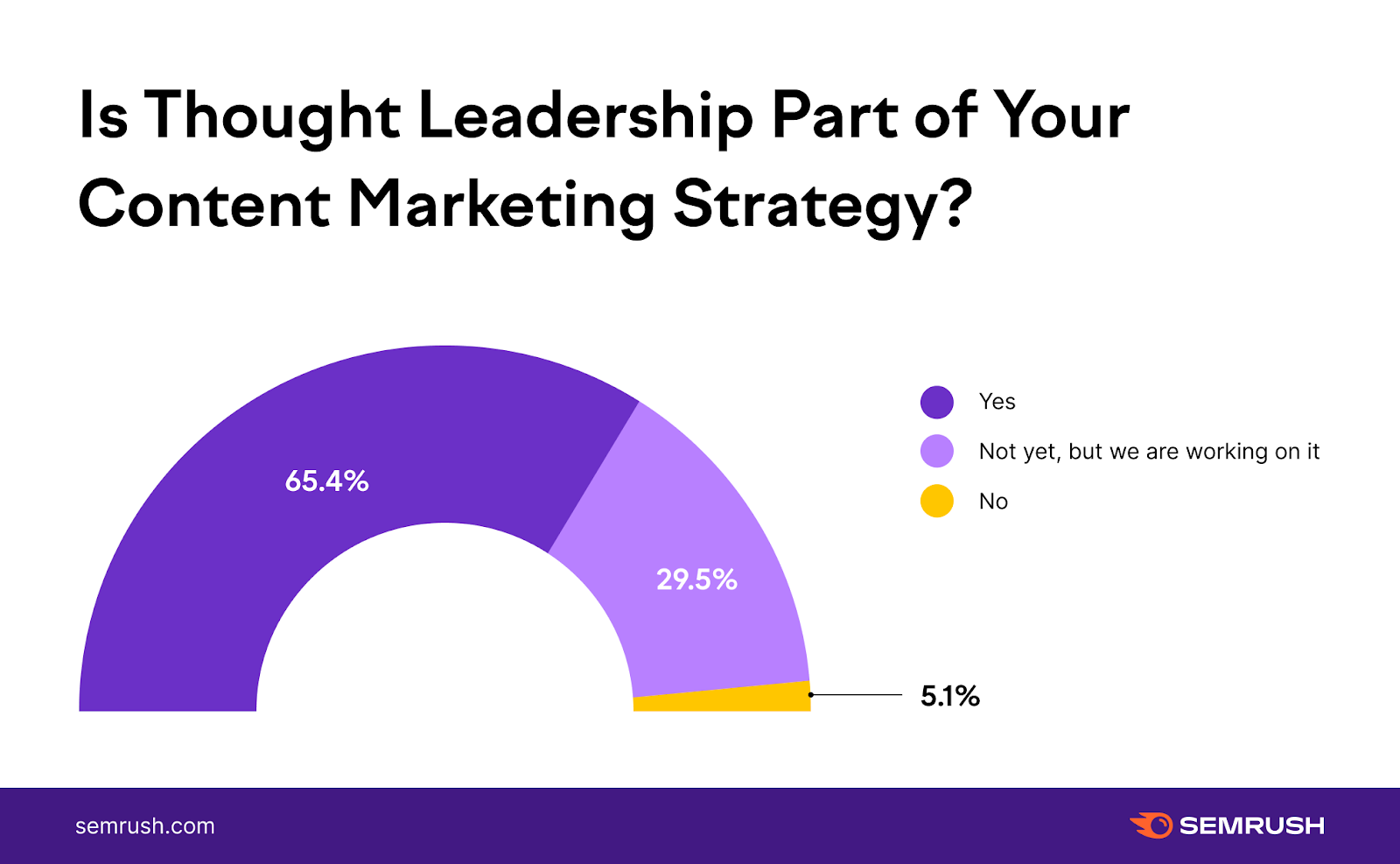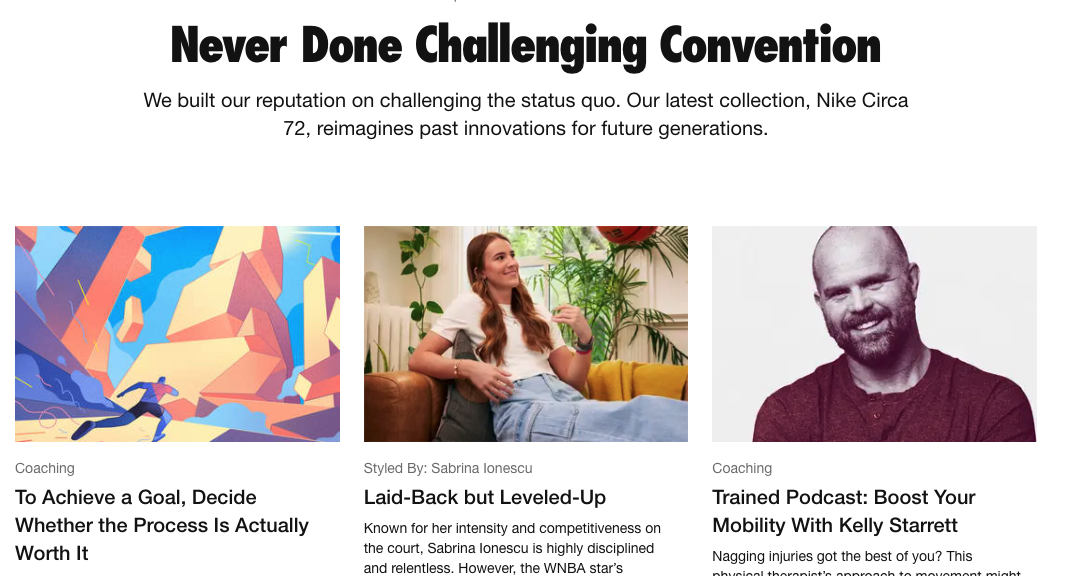The B2B Thought Leader’s Ultimate Guide to LinkedIn (2022 Version)
Are you a thought leader? Or do you want to be one? If so, then LinkedIn is the perfect platform...

While thought leadership is often associated with B2B companies, it can be just as important for B2C brands.
Thought leadership is an invaluable method to build brand trust. It's a way of showing potential customers that you're an expert in your industry and that you can add value to them.
In a world where consumers are savvier than ever, B2C businesses also need to be able to provide expert insights and thought-provoking content in order to stand out from the competition.
In this post, we will discuss what thought leadership is and why it is important. We’ll also discuss the difference between B2C and B2B thought leadership, provide you with some great examples of B2C thought leadership, and give you nine practical tips on how to build an effective thought leadership program.
Let’s first discuss the meaning of thought leadership in general—relevant for both B2B and B2C businesses.
The popularization of thought leadership is relatively new, but did you know that the concept dates back to 1887? That's when Henry Ward Beecher, the abolitionist clergyman, was described in a biography as “one of the great thought-leaders in America.”
Having thought leadership means your audience isn't looking solely for your product or service, but looks up to you as an expert in your field because you share your insights in a way that educates, informs and inspires.
As a thought leader, you deliver truly authentic content to the world, based on your experience and expertise, with the sole purpose of imparting wisdom—not marketing a product (although business growth is ultimately a result of good thought leadership).
Your opinions should provide perspective and guidance that help your customers make better decisions. They can also be bold, controversial or worthy of debate.
To better understand thought leadership, here are some people and businesses that became thought leaders in their respective industries:
Experienced, knowledgeable, transparent, strongly opinionated, and innovative: these CEOs, coaches, authors, and businesses think outside the box to revolutionize their industries and impart knowledge.
According to research by Semrush, 65% of businesses have already implemented a thought leadership marketing strategy, and another 30% are planning to.

Your businesses should not be in the remaining 5%. Here are 8 reasons why you should be interested in becoming a thought leader in 2022:
Reason #1 – thought leadership qualifies you as a reliable source of information with the potential to influence others, including consumers.
Reason #2 – thought leadership helps you build a strong brand identity and enhances your presence in the industry.
Reason #3 – thought leadership provides your consumers with credibility.
Reason #4 – thought leadership encourages innovation by pushing you to think outside the box and come up with novel ideas.
Reason #5 – thought leadership differentiates you from your competitors by establishing brand authority.
Reason #6 – thought leadership attracts leads and potential clients by building a loyal audience.
Reason #7 – thought leadership can fuel PR opportunities in your niche.
Reason #8 – although indirectly, thought leadership can strengthen your SEO backlink profile by improving the likelihood of people linking to your content.
Now we know the importance of thought leadership in general, let's take a closer look at the differences between B2B thought leadership and B2C thought leadership.
The first key difference is the audience. B2B thought leadership is focused on addressing the needs of other businesses, while B2C thought leadership is focused on consumers.
Consumers are often more emotional in their decision-making, while businesses often have multiple decision-makers involved and thus are more likely to base decisions on logic and facts. This means that the content you produce as a B2B thought leader will be quite different from the content you produce as a B2C thought leader.
As the audience is different, so is the focus of the content.
B2B thought leadership is typically geared towards educating prospects on industry trends, best practices, and solutions to common business challenges. B2C thought leadership, on the other hand, often takes the form of brands sharing their unique perspectives on culture, lifestyle, and consumer behavior.

Take, for example, Nike. Nike is a master of B2C thought leadership. Their content is focused on how their products can help you live a healthier, more active lifestyle. They are constantly sharing new research and insights on the science of fitness and human performance. And they use their platform to showcase inspiring stories of athletes who have overcome adversity to reach their goals.
@mermaidstraw Join us for our 4th Annual WORLDWIDE CLEANUP on June 25th! 🌎 Participate from anywhere in the world! #mermaidcleanup #cleanourworld #beachcleanup #mermaidstraw #saveouroceans
♬ Walking On Sunshine - Countdown Singers
Another difference is the format of the content. B2B thought leadership is typically delivered through long-form articles, white papers, eBooks, webinars, and reports. B2C thought leadership, however, is often delivered through (short-form) videos, shorter blog posts, and shorter social media posts.
The tone of the content is also different. B2B thought leadership is usually more formal, while B2C thought leadership is often more casual and conversational. As just explained, this is because businesses are usually more interested in facts and data that will help them make decisions, while consumers are often more emotional in their decision-making, are often more interested in stories and are looking to feel part of a bigger group.
The last difference between B2B and B2C thought leadership is the type of thought leader. In the B2B world, thought leaders are often final decision makers, company owners, partners, and C-Suite Level executives: they write thought pieces, record videos, publish essays, and host webinars and presentations. Brands or companies themselves can be thought leaders, but this is less typical in B2B.
In the B2C world, on the other hand, we often see two types of thought leaders.
In the rest of this guide, we'll focus more on the first B2C thought leader type (brands), to give you, as a business owner or marketeer, more hands-on advice on how to make use of thought leadership for your B2C brand.
From Relate by Zendesk to American Express’ Open Forum, many B2C brands have ridden the thought leadership wave. By opening up about their ethos, and presenting themselves as thought leaders in their respective industries, they can attract a wider audience. Below, we have chosen to dive deeper into three brands that have become thought leaders in the make-up industry, the sustainability industry, and the apparel industry.
M.A.C. Cosmetics is an American cosmetics manufacturer founded in 1984 with a mission to sell professional makeup products to consumers around the globe. Amidst the HIV epidemic, the brand has established the MAC AIDS Fund in 1994 to support people affected by HIV/AIDS, raising over $400 million. However, a campaign that is philanthropic and disconnected from the brand’s niche is not enough to consider MAC a thought leader brand.
However, MAC has fought for its place as a thought leader in the cosmetics industry by starting the MAC Artistry page. Intending to inspire and educate, MAC publishes make-up tutorials created by top-notch experts to help their customers recreate the looks at home. With consumers gaining knowledge and skill, MAC successfully creates brand trust and boosts engagement.
By setting itself apart from its competition, MAC Cosmetics is considered a B2C thought leader in the beauty industry.
Mermaid Straw was founded in 2018 by a married couple of animal, nature, and water lovers that are dedicated to cleaning the planet. According to their mission page, Mermaid Straw is "focused on the reduction of single-use plastics through offering fun & stylish reusable alternatives, community action, and education." Why can they be considered as a B2C Thought Leader?
Firstly, Mermaid Straw sells alternatives to single-use plastic such as straws, cups, bottles, and utensils. Not only that, but they are committed to saving lakes, rivers and oceans by organizing volunteering cleanups that they document on their popular YouTube channel with more than 700,000 subscribers and their Tiktok with 2 million followers! Additionally, they offer their customer base the opportunity to join their cleanups.
Secondly, by visiting Mermaid Straw's website, clients can access the data that the company has collected on sustainability issues. The company has conducted various research justifying the need for an alternative to single-use plastic. Additionally, the brand shows the customer the power that their purchase holds: Mermaid Straws has saved 255,000,000 plastic straws and 571,659 plastic bottles from entering the environment, and their cleanups have resulted in 7,018 pounds of trash not ending up in the ocean. Mermaid Straw is not only educating their consumers online but in schools as well, impacting hundreds of children.
Mermaid Straw is looked at as a true influencer in the sustainability industry, making it a B2C brand thought leader!
Patagonia is a designer of outdoor clothing gear with a clear vision and mission: 1% of the brand's sales are pledged towards the preservation and restoration of the natural environment, with over $89 million awarded to grass-root organizations.
This mission first brand has also invested $10 million toward alleviating the harmful effects of human-caused climate disruption. The brand had originally received the money in tax return due to tax cuts, and was donated under the “urgent gift for the planet” campaign.
The brand has a long history of environmental stewardship by promoting zero-waste initiatives, offering free repairs, and donating to environmental causes. Being one of the only clothing brands with the environment as the central spoke around which it turns, Patagonia is a true B2C thought leader in the apparel industry.
Starting an effective thought leadership campaign is not easy, but don't worry, we got you covered in this guide. We have carefully outlined all the tips you will need to have a successful B2C thought leadership program that is inspired by trust and expertise.

To establish brand credibility and authority, you need to have a three-dimensional brand strategy—one that incorporates a product message, a thought leadership point of view, and a social purpose strategy that are fully aligned with one another.
This means staying true to a clear mission and vision and presenting your audience with reliable information and research. If you sell sustainable products, conduct research on the harm of single-use plastic, and if you sell makeup, research the downside of animal testing.
Building a team of experts to back up your research is key in acquiring that authority in your niche and earning the trust of your customers. Eventually, consumers will be drawn to your ingenuity and sales will follow.
To become an influential B2C thought leader, you need to know which "thought leader industry" you belong to and whom to target. In the example of Mermaid straw, their niche is the sustainability industry and their consumer is a person trying to make small changes in their consumption.
Your audience should naturally be aligned with your buyer personas, since one of your goals as a B2C company thought leader is to drive sales up. You could aim to reach wider audiences if you add lead conversion elements in your campaign.
You need to closely monitor what other brands in your industry are doing to avoid redundancy and to maximize your brand's credibility – copying others' campaigns is never a good idea! In the age of social media, a few clicks on a brand's page will give you a clear idea of its mission statement, values, and what they're doing to educate its consumers.
You could also consider collaborating with an influencer in your niche to bring traffic to your brand. Influencers are a great investment in B2C companies since they are strong thought leaders with great credibility and are trusted by many.
If you're considering partnering with an influencer, here are the key factors to look for:

Boring and repetitive content will bring your brand down and will drive traffic away from your website. Your brand needs to create thought leadership content that is smart and enjoyable. Today's consumer is looking for originality, and by using these simple tips, your brand will easily produce the best content.

The new generation of internet users is using TikTok as a search engine. If you want to target Gen Z, use TikTok as the way to reach them. Create short videos that are creative and informative. Educate your audience on your product or service. Be entertaining and personable in your videos.
If your brand is truly seeking to become a thought leader, then having a blog is key!
Your blog will signal your authority to your customers and will directly impact trust. You will be able to publish any research you conduct as a brand, and if optimized correctly, will be able to drive new customers to your website.
Don’t be afraid of offering proactive ideas that challenge specific assumptions about a certain topic. For instance, if using single-use straws is the norm, dare to offer a reusable option after pointing out environmental issues. Don’t do it because you want to drive sales, do it because it’s what your brand believes in, turnover will follow!
By delving into specific topics and offering subject matter expertise, you will gain the trust of your audience and you will become a respected thought leader brand.
-png.png)
A thought leader is not only someone who provides content, but someone who also engages with their audience. A thought leader builds a community of followers who respect and value their opinion.
Think about ways you can engage with your audience outside of just producing content. Can you host events? Can you create an online space or participate in online forums where your followers can interact with each other? Can you provide opportunities for your followers to collaborate with you or each other?
By fostering a community, you will deepen the relationships you have with your followers and make them more likely to continue consuming your content and engaging with your brand.
While it may seem like you need to make some grand gesture to be a thought leader, that is not the case. You can start small and still have a big impact. In the beginning, focus on your niche and audience. Build a following by providing valuable content that educates, entertains, or both. As you grow your platform, you can start to branch out and address other issues that are important to you. Remember, your goal is not to save the world, but to make a difference in the lives of your consumers.
Striving to become a trusted B2C thought leader can seem challenging at first, but it is worth the investment. With rapidly shifting buyer preferences and increased competition, brands should reevaluate whether their thought leadership strategy is meeting the customer's expectations.
Don't be intimidated when you hear that thought leadership is only reserved for B2B enterprises: expertise exists in the consumer world, and influencers are the biggest proof. Just be sure to stay true to your brand's mission and purpose.

Perla is a doctoral student at Notre Dame Law School. She loves writing and sharing knowledge with others.

Are you a thought leader? Or do you want to be one? If so, then LinkedIn is the perfect platform...

(Following is Chapter 15 of Trust Signals: Brand Building in a Post-Truth World.)
According to the...
Leave a Comment